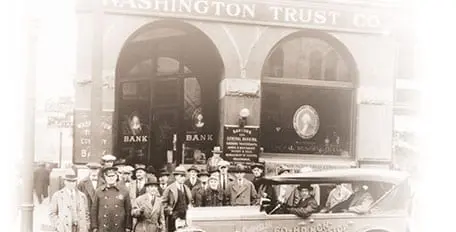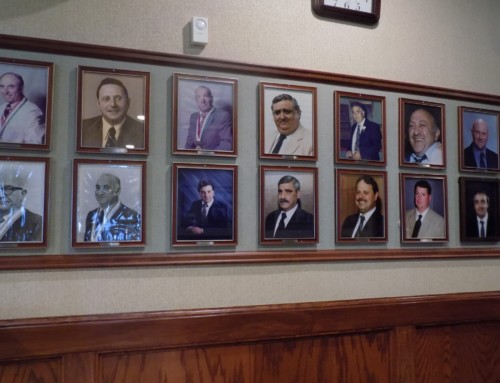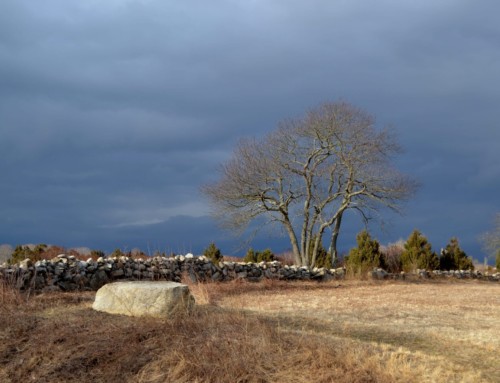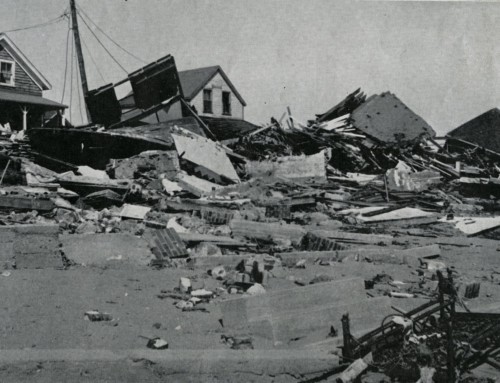Several other men would hold the role of president of Washington Bank before Charles Perry Sr.’s nomination in 1881. Jeremiah Thurston replaced Thomas Noyes upon the latter’s death in 1819, serving until 1830. Thurston, who served as Lieutenant Governor of Rhode Island from 1816 to 1817, represented the first in a line of several prominent politicians to be named bank President.[16] Thurston’s successor was Nathan Fellows Dixon, who simultaneously served the bank in addition to his role as a United States Senator representing Rhode Island from 1839 until his death in 1842.[17]
As was the case with the Perry family, the Dixon family would also become a significant clan in the history of the Washington Bank. Nathan F. Dixon (I)’s son, Nathan Jr. held the ship steady for nearly four decades during his time as President of the bank from 1842 until his death in 1881.[18] While Nathan Jr. was among the long-serving Presidents in the history of the bank, he also embarked on a career in politics that provided him with a front-row seat to several of the century’s most notable historical events.
Dixon held a seat in the Rhode Island House of Representatives for four non-concurrent terms totaling 21 years between 1841 and 1877. Shortly into his first term, Dixon was a member of the Governor’s Council which helped guide Samuel Ward King through the Dorr Rebellion.[19] He also served in the United States House of Representatives
From 1863 to 1871 after having been elected by the citizens of Rhode Island to represent their interests while America was engaged in the Civil War.[20] Dixon Jr.’s presidency was followed by that of Charles Perry Sr. who then passed the torch in 1890 to Nathan F. Dixon III, also a United States Senator representing Rhode Island just as his grandfather was before him.[21]
For many years, the history of the Washington Bank was relatively mundane as operations were both successful and remarkably consistent. It was during the presidency of Dixon Sr. that the most noteworthy change in the bank’s early history took place. In 1836, a building was constructed, providing the bank with their own facilities for the first time. The doric-style Greek temple was built of Westerly granite and was located facing Broad Street where the current bank building now stands.[22] The “Greek temple” as the building was known, stood until 1924 when it was dismantled and replaced.
While many banks have come and gone throughout Washington Trust’s history, few local institutions have offered sustained competition. The Westerly Savings Bank was one of the few institutions which had long-lasting success, surviving for half a century alongside the Washington Bank.[23] By the 1850s a new class of workers was growing in New England and more and more people were looking to save their hard-earned wages, opening the door for the Westerly Savings Bank.
The Westerly Savings Bank was incorporated in 1854 and operated throughout its entire history out of the Washington Bank building.[24] The Washington Bank and the Washington Savings Bank were closely associated with one another and there were many ties between the two as both institutions shared several board members. In 1904, after a long period of growth, the two banks were merged, forming the Washington Trust Company. [25]
The 1860s brought about another major change for the Washington Bank. On February 23, 1863, the National Bank Act of 1863 was passed, creating a system of national banks while levying a significant tax on state-chartered banks unless they received a national charter. In response to this law, the Washington Bank was granted a national charter and was rechristened Washington National Bank.[26]
Over the course of the 19th century, there was only one known attempt at robbing the Washington National Bank. On December 28, 1870, at just around one in the morning, Captain Jonathan Crandall, a bank watchman was seriously wounded in his effort to apprehend would-be robbers.[27] Initially, it was believed that Crandall, who was shot in the head, would not survive leading several news outlets to report the crime as a murder, but it was later said that he was expected to survive after several months in recovery.[28]
The four banks in Westerly at the time offered a $5,000 reward for the capture of the assailants but it is not known if the robbers were ever found.[29] The Washington National Bank persevered through national economic crises in 1873 and 1893, never faltering despite widespread repercussions for other banks across the country, allowing them to remain a mainstay of the local economy as they began their second century in 1900.
[su_accordion class=””] [su_spoiler title=”Footnotes” open=”no” style=”default” icon=”plus” anchor=”” class=””]
17. Biographical Directory of the United States Congress, Nathan Fellows Dixon, https://bioguideretro.congress.gov/Home/MemberDetails?memIndex=D000376.
18. Cooney, Ralph Bolton, Westerly’s Oldest Witness: How Westerly and the Washington Trust Company Have Progressed Together for 150 Years, (1950), pg. 81.
19. Biographical Directory of the United States Congress, Nathan Fellows Dixon, https://bioguideretro.congress.gov/Home/MemberDetails?memIndex=D000375
20. Biographical Directory of the United States Congress, Nathan Fellows Dixon, https://bioguideretro.congress.gov/Home/MemberDetails?memIndex=D000375
21. Biographical Directory of the United States Congress, Nathan Fellows Dixon, https://bioguideretro.congress.gov/Home/MemberDetails?memIndex=D000377
22. Cooney, Ralph Bolton, Westerly’s Oldest Witness: How Westerly and the Washington Trust Company Have Progressed Together for 150 Years, (1950), pg. 38.
23. Cooney, Ralph Bolton, Westerly’s Oldest Witness: How Westerly and the Washington Trust Company Have Progressed Together for 150 Years, (1950), pg. 30.
24. “The Washington Trust Company of Westerly, Rhode Island” The Banker’s Magazine, vol. LXXXIII, 1911, pg. 249-250.
25. “The Washington Trust Company of Westerly, Rhode Island” The Banker’s Magazine, vol. LXXXIII, 1911, pg. 249-250, and Cooney, Ralph Bolton, Westerly’s Oldest Witness: How Westerly and the Washington Trust Company Have Progressed Together for 150 Years, (1950), pg. 55.
26. Chalk, Sandra Kersten, Washington Trust: Two Hundred Years Along the Pawcatuck, (2000), pg. 55.
27. “Shocking Affair in Westerly” Providence Evening Bulletin, 28 December 1870.
28. “New England News” Fall River Daily Evening News, 22 February 1871.
29. “Rewards.” New York Daily Herald, 19 January 1871.






